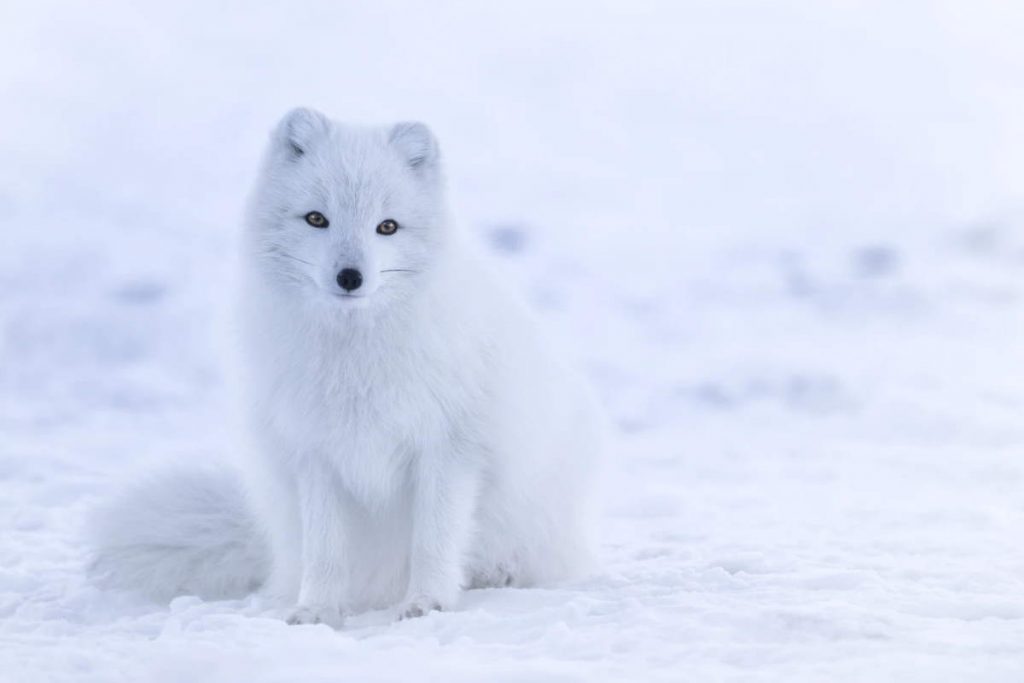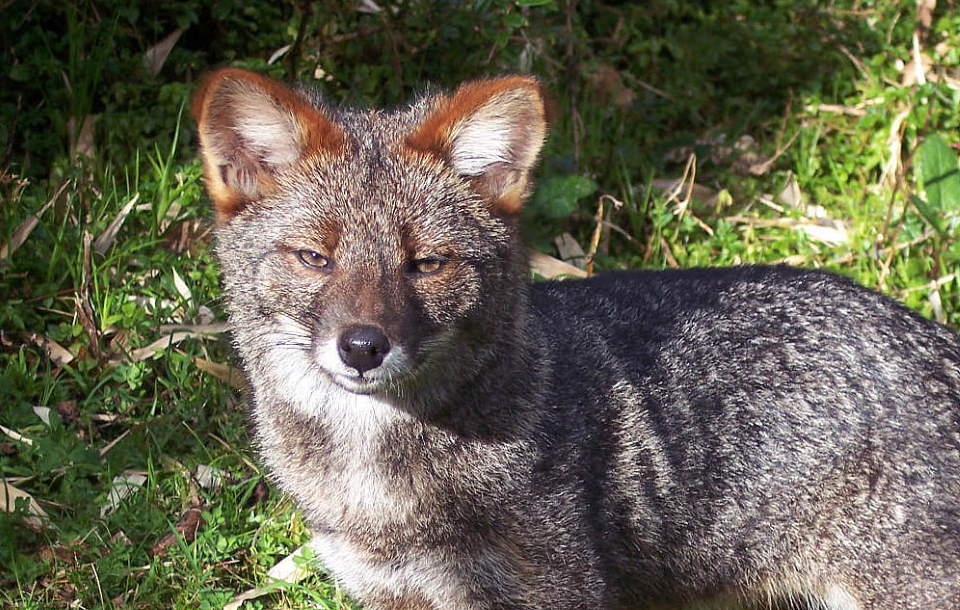Foxes are small to medium-sized, omnivorous mammals. They belong to the dog family (Canidae, from Latin, canis, “dog”, see notes 1). Here are 20 amazing fox facts.

Fox facts
1. Foxes are the most widespread species of wild dog
They live on every continent except Antarctica. 12 fox species belong to the “true foxes” group of genus “Vulpes”. Another 25 current or extinct species are usually called foxes.
The red fox (Vulpes vulpes) is the most common and widespread.
2. They can eat almost anything
They are omnivores. From berries and rubbish to worms and birds, they can eat almost anything. But some species have a more specialized diet, for example, the crab-eating fox (Cerdocyon thous) – they are not closely related to true foxes, though.
3. Foxes can retract their claws as cats do
They also have vertical pupils that are similar to cats. These vertical pupils allow them to see in dim light. Dogs, on the other hand, have rounded pupils and cannot retract their claws.
The similarities between foxes and cats do not end here. Foxes also have sensitive whiskers and spines on their tongues.
4. North American grey foxes can climb trees
Thanks to their retractable claws, North American grey foxes can climb trees ğ- a feat shared only with the Asian raccoon dog and the New Guinea Wild Singing Dog among all canids. Some of them even sleep on trees like cats.
5. They are usually solitary animals
Unlike many canids, foxes are not always live in packs. They prefer to live in small families when raising their cubs. But, when they are cub-free, they prefer to live, hunt, and sleep alone.
6. They were domesticated by the early humans
According to a 2019 study, foxes were domesticated by humans in the Bronze age.
In the northeast of the Iberian Peninsula, between the third and second millennium BC, a widespread funeral practice consisted of burying humans with animals – mostly dogs, and a few foxes.
Based on assumed human care of a healed metatarsal fracture from one animal, and on relatively low nitrogen stable isotope values suggesting anthropogenic low protein diet, scientists think that both foxes and dogs were domesticated, as their diet was similar to that of their owners.
7. Foxes can use the Earth’s magnetic field to detect distance
A lot of animals can detect the direction of the Earth’s magnetic field. But, foxes also have the amazing ability to use it to detect distance as well as direction. They are the first animals thought to have this incredible ability.
8. Foxes cannot see, hear, or walk after birth
Foxes, like coyotes, meet to mate in winter and babies born in spring. The vixen (female) typically gives birth to a litter of 2 to 12 pups.
At birth, they are covered with short, dark fur – even red foxes have dark brown or black fur when they are born. Their eyes are closed and will remain closed for several weeks.
At birth, their feet are also not well-coordinated, so they cannot walk.
“Kits” stay with their parents for about 7 months.
9. Foxes live in dens
Foxes live in a “den” which is made by digging a hole in the ground.
A female fox is called a vixen. A male fox is called a “dog fox” or a “tod”. Baby foxes are called “pups”, “kits”, or “cubs”. A group of foxes is referred to as a “skulk”, “leash”, or “earth”.
10. Arctic foxes shiver until the temperature drops to -70°C (-94°F)
Thanks to its dense, multilayered pelage, which provides excellent insulation, the Arctic fox (Vulpes lagopus) lives in some of the most frigid extremes on the planet, but they do not start to shiver until the temperature drops to -70°C (-94°F).

11. Smallest fox species weigh 1-1.9 kg (2.2-4.2 lb)
The smallest fox species, also the smallest of all canids, the fennec fox (Vulpes zerda) lives in the Sahara Desert and the Sinai Peninsula. Females of this species range in head-to-body size from 34.5 to 39.5 cm (13.6 to 15.6 in) with a weight of 1-1.9 kg (2.2-4.2 lb). Males are slightly larger, ranging in head-to-body size from 39 to 39.5 cm (15.4 to 15.6 in), weighing at least 1.3 kg (2.9 lb). Smaller than a house cat!
They have long ears and look very cute.


Related: 10 amazing Fennec Fox facts
12. They are vocal animals
Their vocal repertoire is vast: they whine, yelp, growl, bark, and can produce many other voices. They can produce more than 40 different sounds.
13. They are short-lived
They don’t live long. In the wild, their typical lifespan is 1 to 3 years, although some individuals may live up to 10 years.
Like other wild animals, captive individuals live longer, up to about 14 years, comparable to domestic dogs.
14. They stink
Foxes are smelly. They have a sickly, musty scent that comes from the glands at the base of their tails.
15. Red foxes have excellent hearing
Red foxes have excellent hearing that helps them to identify prey underground. They can hear rodents digging miles, for example.
It’s reported that red foxes can hear a watch ticking from 40 yards (36.5 meters) away!
16. They are playful
Foxes are playful and curious. Like cats and dogs, they interact and play with each other. They’re also in love with balls – they’ve even been seen stealing balls from backyards and golf courses.
17. Charles Darwin discovered a fox species
And it’s called -guess it- Darwin’s fox (scientific name: Lycalopex fulvipes). It was first spotted by him in San Pedro Island in the Chiloé Archipelago (Chile) in December 1834 during the Beagle survey expedition.
Darwin’s fox is listed as endangered by the IUCN.

18. Urban foxes exist
They were adapted to a certain degree to living in urban (mostly suburban) human environments. Thanks to their omnivorous diet, they are able to survive on discarded food waste.
19. They are nocturnal
They are primarily nocturnal animals (they are active at night). But urban foxes can be seen during the day.
20. They hide their food to consume later
Foxes cache their food – they bury it to consume later, hiding it fast before some other animal takes it. An urban fox will go from house to house repeating the process. They’ll consume the food they hid when they’re hungry.
Some not so-amazing Fox facts

Unfortunately, because they have beautiful fur, there is a whole industry that both breeds captive foxes and traps foxes in the wild for their fur. Captive foxes live under horrible conditions in fur factory farms.
Foxes are often considered pests, that’s why people kill them. They are often blamed for damage in fact they did not do. They are also considered dangerous to people and pets. In fact, confirmed attacks on people are extremely rare. They present no danger to humans unless they are rabid, which is also very rare. There’s also no evidence that the parasites and diseases foxes may be carrying pose any significant risk to people or domestic pets.
Fox hunting is also a tradition in the UK. Hunting with dogs is now banned but hunting without dogs is still permitted.
Notes
- Canidae (from Latin, canis, “dog”) is a biological family of dog-like carnivorans. A member of this family is called a canid. Domestic dogs, wolves, and foxes are examples of canids.
Sources
- Fox on Wikipedia
- Study: “Foxes were domesticated by humans in the Bronze Age” on the Science Daily website
- “14 Fascinating Facts About Foxes” on Mental Floss
- “Top Ten Fun Fox Facts” on Earth Rangers
- “Foxes zero in on prey via Earth’s magnetic field” on New Scientist
- “9 Fox Facts You May Not Know” on the Killingsworth Environmental website
- What’s so bad about fox hunting? on How Stuff Works
- “Fact vs. Fiction – the myths surrounding the Hunting Act” on rspca.org.uk
- “Urban foxes, your questions answered” on bbcwildlife.org.uk
- Budget of NASA, Year by Year [1980-1989] - June 10, 2024
- Budget of NASA, Year by Year [1970-1979] - June 10, 2024
- Budget of NASA, Year by Year [1958-2024] - June 10, 2024
